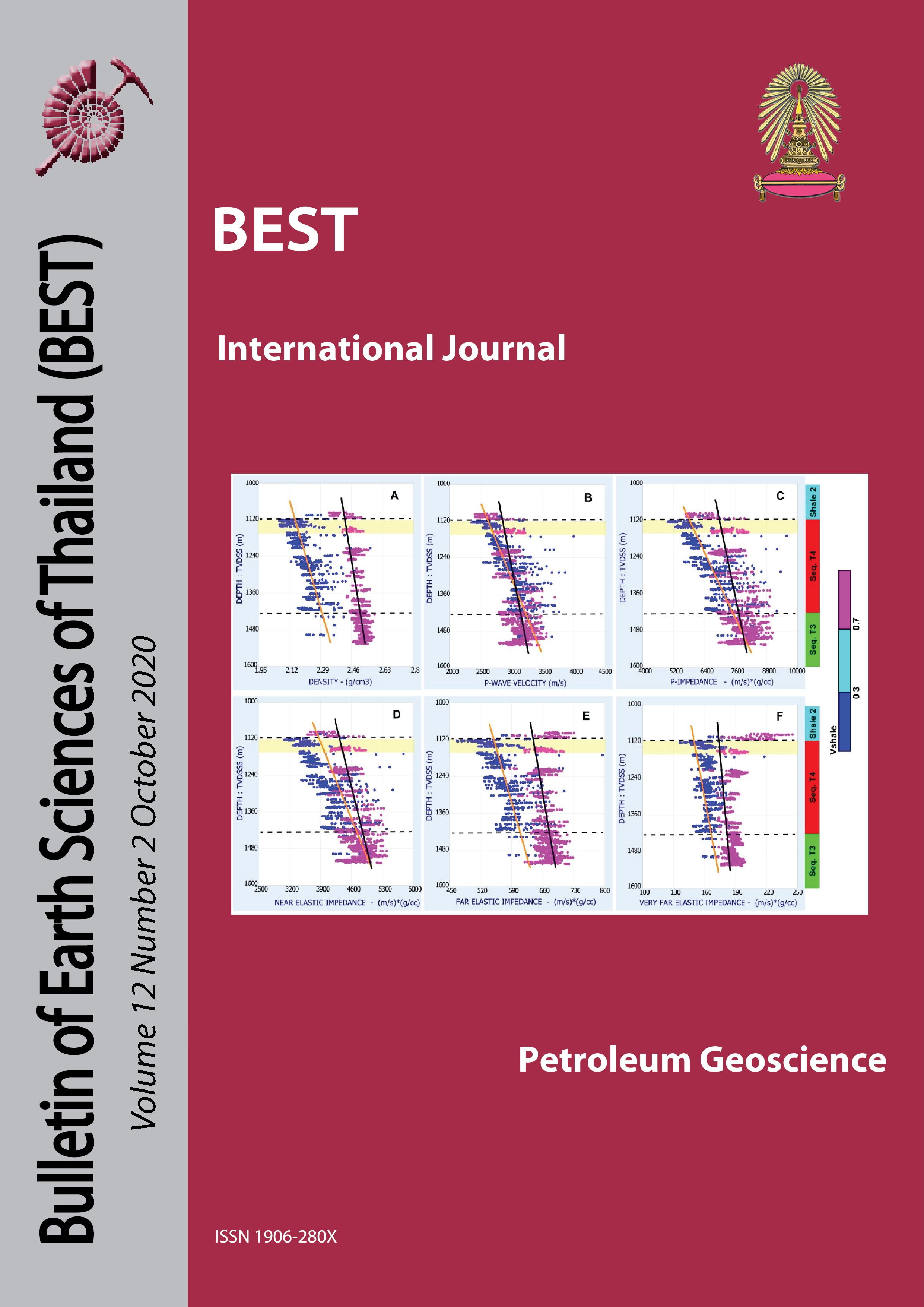2D Petroleum System Modelling and Hydrocarbon Potentiality of Huai Hin Lat Formation, Khorat Plateau, Thailand
Main Article Content
Abstract
Huai Hin Lat Formation has been known as significant source rock for petroleum system in Khorat Plateau, North East Thailand. It is believed to commence depositing in an initial rift sequences since and through Triassic period associated with Indosinian orogeny which catastrophically influences over source rock characterization in Thailand. The integration of geological acquisition, geochemical analysis and geophysical approaches has been applied to evaluate hydrocarbon potentiality of Huai Hin Lat Formation in the aspects of generation, qualification and migration. The studied outcrop is composed of organic shale, sandstone and interbedded layers Total Organic Carbon (TOC) range from 0.02 to ~1 wt.% which is poor to fair for petroleum potential. Kerogen is classified as type III (gas-prone) considered by low Hydrogen Indices (HI) and high Oxygen Indices (OI). While thermal indicator, Maximum Temperature (Tmax) range in 348°C to 545°C mentioned immature and postmature stage agreed with Vitrinite Reflectance (R๐%), ranging in high values of 1.60 to 1.91. Extractable Organic Matter (EOM), fall in the very low range of 19.81-79.94 ppm, which are immature. Most of Pristane to Phytane (Pr/Ph) ratios are more than 3.0 suggested terrigenous organic matter deposited under oxic to suboxic condition inferring to lacustrine environment, Pristane to Heptadecane (Pr/n-C17) and Phytane to Octadecane (Ph/n-C18) figure out paleo-depositional environment of organic matter as high oxidizing terrestrial area which can provide kerogen type III. Seismic interpretation reflected rifting system geometry in which Huai Hin Lat Formation was found in half-graben and also conformably lay over Permian carbonate which is expected reservoir. However, there is no evident of migration pathway can be observed in 2D petroleum system models. Moreover, maturity model showed late stage of maturity according to the high present-day temperature model (over 100°C) and supportively with high hydrocarbon transformation ratio model. Considering via less promising in hydrocarbon generation, rather poor in hydrocarbon qualification, high degree of maturation and restricted hydrocarbon migration, Huai Hin Lat Formation in this study is concluded to possess low hydrocarbon potentiality.
Article Details

This work is licensed under a Creative Commons Attribution-NonCommercial-NoDerivatives 4.0 International License.
Copyright © 2008 Department of Geology, Faculty of Science, Chulalongkorn University. Parts of an article can be photocopied or reproduced without prior written permission from the author(s), but due acknowledgments should be stated or cited accordingly.
References
Al-Areeq, N. (2018). Petroleum Source Rocks Characterization and Hydrocarbon Generation.
Ali, A. (2012). Basin Modelling: HC Generation Modelling of the Åre, Melke and Spekk Formations, Haltenbanken Area.
Altermann, W., Grammel, S., Ingavat, R., Nak- ornsri, N. & Helmcke, D., (1983). On the evolution of the Paleozoic terrains bordering the Khorat Plateau. In Conference on the Geology and Mineral Resources of Thailand (ed. Bunopas, S.), pp. 1–5. Bangkok, Thailand: Department of Mineral Resources.
Racey A., Love, M.A., Canham A.C., Goodall, J. G. S. , Polachan S., Jones, P. D. (1996). Stratigraphy and reservoir potential of the Mesozoic Khorat Group, NE Thailand. Journal of Petroleum Geology, vol. 19(1), January 1996, pp. 5-40.
Ben-Awuah, J., Adda, G., Mijinyawa, A., Andriamihaja, S., Siddiqui, N., 2013. 2D Basin Modelling and Petroleum System Analysis of the Triassic Play in the Hammerfest Basin of the Norwegian Barents Sea. Research Journal of Applied Sciences, Engineering and Technology. 6. 3137-3150.
Chonglakmani, C. , and Sattayarak, N. ( 1978). Stratigraphy of the Huai Hin Lat Formation ( Upper Triassic) in northeastern Thailand. In the Proceedings of the third regional conference on geology and minerals resources of Southeast Asia. Bangkok.
Gonzalez-vila, F. J., 1995. Alkane biomarkers geochemical significance and application in oil shale geochemistry, In: Snape, C. (ed) composition, geochemistry and conversions of oil shales. Kluwer Academic Publishes pp. 51-68.
Hantschel T., Kauerauf A.I. (2009). Introduction to Basin Modeling. In: Fundamentals of Basin and Petroleum Systems Modeling. Springer, Berlin, Heidelberg.
Higley, D. (2014). Thermal maturation of petroleum source rocks in the Anadarko Basin Province, Colorado, Kansas, Oklahoma, and Texas, chap. 3.
K.R. Al-Arouri. (1996). Petroleum geochemistry, source rock evaluation and modelling of hydrocarbon generation in the southern Taroom Trough, with particular reference to the Triassic Snake Creek Mudstone. University of Adelaide, PhD Thesis.
Minezaki, Tomonari & Hisada, Kenichiro & Hara, Hidetoshi & Kamata, Yoshihito. (2018). Tectono-stratigraphy of Late Carboniferous to Triassic successions of the Khorat Plateau Basin, Indochina Block, northeastern Thailand: Initiation of the Indosinian Orogeny by collision of the Indochina and South China blocks. Journal of Asian Earth Sciences. 170.
Rontani, J.F.; Volkman, J.K. (2003). Phytol degradation products as biogeochemical tracers in aquatic environments. Organic Geochemistry. 34 (1): 1–35.
Van Balen, R., Van Bergen, F., De Leeuw, C., Pagnier, H., Simmelink, H., Van Wees, J., & Verweij, J. (2000). Modelling the hydrocarbon generation and migration in the West Netherlands Basin, the Netherlands. Netherlands Journal of Geosciences - Geologie En Mijnbouw, 79(1), 29-44.


